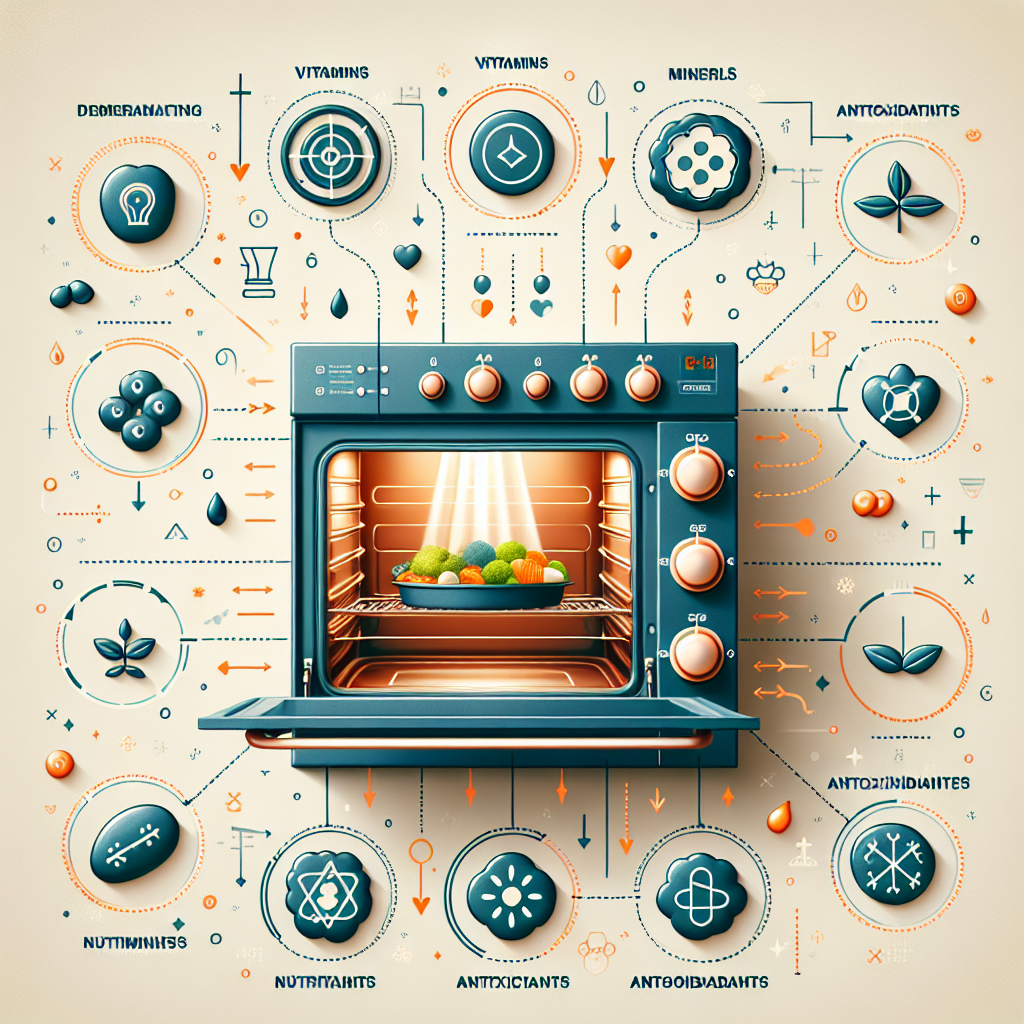Are you curious about the benefits of steam cooking in ovens and how it helps preserve the nutrients in your food? Well, look no further! In this article, we will explore the science behind steam cooking and its impact on the nutritional value of your meals. By understanding this fascinating process, you will be equipped with the knowledge to make healthier choices in the kitchen and ensure that your family enjoys wholesome, nutrient-rich meals every day. So, let’s dive into the world of steam cooking and unravel the secrets behind its nutrient-preserving powers.
The Basics of Steam Cooking
Steam cooking is a method of cooking that utilizes steam to cook food. Instead of using direct contact with water or oil, steam is used to transfer heat to the food, resulting in a moist and tender end product. This cooking technique has gained popularity due to its ability to preserve nutrients, enhance flavors, and produce healthier meals. If you are looking for a healthier and more efficient way to prepare your meals, steam cooking might just be the perfect choice for you.
Definition of Steam Cooking
Steam cooking involves cooking food using the steam produced by boiling water. This can be done in various appliances, such as steam ovens or combination ovens with a steam function. By surrounding the food with hot, pressurized steam, it creates a gentle and moist cooking environment, resulting in food that is cooked evenly and retains its natural flavors.
Methods of Steam Cooking
There are several methods of steam cooking, each with its own unique benefits and techniques. The two most common methods are steaming and baking with steam. Steaming involves placing the food in a steamer basket or on a steaming rack, suspended above simmering water. Baking with steam, on the other hand, involves introducing steam into a conventional oven to create a moist cooking environment.
Key Benefits of Steam Cooking
Steam cooking offers numerous benefits that make it a popular choice for health-conscious individuals. Firstly, it helps to retain the natural nutrients in food. Unlike traditional cooking methods that can lead to nutrient loss, steam cooking gently cooks the food, preserving its vitamins and minerals. Secondly, steam cooking requires little to no oil, making it a healthier option for those on a low-fat diet. Lastly, steam cooking helps to maintain the natural flavors and textures of the food, resulting in delicious and satisfying meals.
The Mechanism Behind Nutrient Preservation
To understand how steam cooking preserves nutrients, it is important to explore the effects of heat on these essential components.
Effects of Heat on Nutrients
Heat, particularly at high temperatures, can cause nutrients to break down and degrade. Water-soluble vitamins, such as vitamin C and B vitamins, are especially vulnerable to heat and can be easily lost during the cooking process. On the other hand, fat-soluble vitamins, like vitamin A, D, E, and K, are more stable and tend to withstand higher temperatures.
Traditional Oven Cooking vs. Steam Cooking
Traditional oven cooking methods, such as baking or broiling, often involve higher temperatures that can lead to nutrient loss. The extended exposure to heat can result in a significant reduction in the nutritional value of the food. Steam cooking, on the other hand, utilizes lower temperatures and provides a gentler cooking environment, minimizing nutrient degradation.
Role of Steam in Preserving Nutrients
Steam plays a crucial role in the preservation of nutrients during the cooking process. By cooking food in a moist atmosphere, steam reduces the risk of nutrient loss and helps to retain the vitamins and minerals present in the food. The steam acts as a barrier, preventing the escape of water-soluble nutrients and reducing their exposure to direct heat.

Retaining Nutrients with Steam Cooking
Steam cooking offers many advantages when it comes to retaining nutrients in food. Both water-soluble and fat-soluble nutrients can be effectively preserved through this cooking method.
Water-Soluble Nutrients and Steam Cooking
Water-soluble nutrients, such as vitamin C and B vitamins, are particularly sensitive to heat and can easily be leached out of food during cooking. Steam cooking helps to mitigate this loss by minimizing direct contact with water and providing a gentler cooking environment. By steaming vegetables, for example, you can retain a higher percentage of these heat-sensitive nutrients compared to other cooking methods.
Fat-Soluble Nutrients and Steam Cooking
Fat-soluble nutrients, such as vitamins A, D, E, and K, are more stable and can withstand higher temperatures. While steam cooking may result in minimal loss of fat-soluble nutrients, it is still a preferred cooking method as it helps to prevent excessive heat exposure, ensuring a higher retention of these important nutrients.
Preventing Nutrient Loss During Cooking
To further minimize nutrient loss during steam cooking, it is recommended to cut food into larger pieces or leave them whole. This reduces the surface area exposed to direct heat and helps to preserve more nutrients. Additionally, shorter cooking times are advised to avoid overcooking the food and degrading its nutritional content.
Retaining Color, Flavor, and Texture
One of the remarkable benefits of steam cooking is that it helps to retain the natural color, flavor, and texture of the food. As the steam gently cooks the ingredients, their vibrant colors remain intact, resulting in visually appealing dishes. Furthermore, the natural flavors are preserved, allowing you to enjoy the true taste of each ingredient. Lastly, steam cooking ensures that the food remains tender and moist, contributing to a pleasing texture.
Steam Cooking Appliances
To fully embrace the benefits of steam cooking, it is essential to have the right appliances in your kitchen. There are several options to choose from, each tailored to specific cooking needs.
Steam Ovens
Steam ovens are specialized appliances that are designed solely for steam cooking. They provide a controlled and precise cooking environment, allowing you to maintain the perfect balance of heat and steam. Some popular steam oven brands include Miele, Bosch, and Thermador, offering a range of models with various features and cooking capacities.
Combination Ovens with Steam Function
For those looking for versatility, combination ovens with a steam function are an excellent choice. These ovens offer both traditional convection cooking methods and the option to introduce steam into the cooking process. Brands like Wolf, KitchenAid, and JennAir offer combination ovens with steam functions that provide the best of both worlds.
Steam Cooking Accessories
If you already have an oven or stovetop, you can still enjoy the benefits of steam cooking by using steam cooking accessories. Steamer inserts for pots or microwave steamers are simple yet effective tools that allow you to steam vegetables, fish, and other foods without the need for additional appliances. Some well-known brands that offer steam cooking accessories include OXO, Norpro, and Progressive.
Popular Steam Cooking Brands and Models
When it comes to choosing steam cooking appliances, some popular brands stand out for their quality and innovation. Miele, known for its precision and durability, offers a range of steam ovens that cater to diverse cooking needs. Bosch, with its cutting-edge technology and sleek design, provides steam ovens that combine functionality and style. Thermador is another reputable brand with steam ovens that deliver professional-grade performance and versatility.

Recommended Cooking Techniques
Steam cooking can be used for a wide range of ingredients and dishes, each requiring specific techniques to optimize taste and texture.
Steaming Vegetables
Steaming vegetables is one of the simplest and most popular steam cooking techniques. Cut your preferred vegetables into uniform pieces, place them in a steamer basket or on a steaming rack, and cook them until they reach the desired tenderness. The result is flavorful and vibrant vegetables that retain their nutrients and natural flavors.
Steaming Fish and Seafood
Steaming fish and seafood is an ideal way to preserve their delicate flavors and textures. Season the fish with your preferred herbs and spices, wrap it in parchment paper or aluminum foil, and steam until it is cooked through. The gentle heat of steam ensures moist and succulent seafood, without compromising on taste or nutritional value.
Steam-Cooking Meats and Poultry
While traditionally associated with lighter proteins like vegetables and fish, steam cooking can also be used for meats and poultry. Marinate the meat or poultry, place it on a raised rack in a steam oven or covered dish, and steam until fully cooked. This method helps to retain the natural juices and tenderness of the meat, resulting in flavorful and healthier dishes.
Baking with Steam
Steam can also be introduced into the baking process to achieve various culinary creations. Breads and pastries benefit from the initial burst of steam during baking, creating a crisp crust and light, airy interior. To achieve this, simply place a pan of water in the oven or use a steam oven with a baking function. This technique allows you to elevate your baking skills and produce professional-quality goods.
Steaming Grains and Legumes
Steaming grains and legumes, such as rice, quinoa, and lentils, helps to retain their natural flavors and nutrients. Rinse the grains or legumes under cold water, then add the appropriate amount of water or broth to a pot with a steamer insert. Steam until fully cooked, and you will end up with fluffy and flavorful grains or legumes, ready to be enjoyed as a side dish or incorporated into other recipes.
Preparing Desserts with Steam
Steam cooking can be a versatile method for creating delectable desserts. From classic puddings to custards and savory soufflés, steam cooking is a gentle and even way to achieve perfectly cooked treats. Utilize individual ramekins, mold pans, or silicone molds to create your desired desserts, then steam them until set or cooked through. The result is melt-in-your-mouth desserts that retain their flavor and texture.
Scientific Studies on Nutrient Preservation
The benefits of steam cooking in preserving nutrients have been supported by scientific studies. These studies provide valuable insights into the advantages of steam cooking over other cooking methods.
Study 1: Comparing Nutrient Preservation in Different Cooking Methods
A study published in the Journal of Food Science compared the nutrient retention of broccoli cooked by boiling, microwaving, and steaming. The results showed that steaming retained the highest levels of vitamin C and other water-soluble nutrients compared to boiling and microwaving. This study highlights the importance of steam cooking in preserving vital nutrients in vegetables.
Study 2: Impact of Steam Cooking on Vitamin Content
In a study published in the Journal of Agricultural and Food Chemistry, researchers examined the effects of steam cooking on the vitamin content of various vegetables. The findings indicated that steam cooking led to minimal vitamin loss compared to other cooking methods, preserving important nutrients like vitamins C, B6, and E. The study concluded that steam cooking is an excellent way to maximize the retention of vitamins in vegetables.
Study 3: Retention of Antioxidants in Steam-Cooked Foods
Antioxidants play a crucial role in maintaining overall health, and steam cooking has proven to be effective in retaining these beneficial compounds. A study conducted by the University of Murcia in Spain evaluated the antioxidant capacity of vegetables after different cooking methods. The results showed that steam cooking preserved a higher antioxidant capacity when compared to boiling and frying. This research demonstrates the positive impact of steam cooking on the retention of antioxidants.
Factors Affecting Nutrient Preservation
While steam cooking is an effective method for preserving nutrients, certain factors can influence the extent of preservation.
Cooking Time and Temperature
The cooking time and temperature greatly affect the retention of nutrients. Longer cooking times and higher temperatures can accelerate nutrient loss, so it is important to cook food for the recommended duration at the appropriate temperature. Steam cooking allows for precise control over these variables, ensuring optimal nutrient preservation.
Food Thickness and Size
Thicker cuts of food or larger pieces require longer cooking times, which may result in greater nutrient loss. To minimize this, it is advisable to cut food into smaller, uniform sizes. By reducing the thickness or size of the ingredients, you can ensure more even and efficient cooking, thereby preserving nutrients.
Quality and Freshness of Ingredients
The quality and freshness of ingredients can directly impact their nutrient content. Choosing high-quality and fresh produce allows you to start with a higher nutritional foundation. Where possible, opt for organic or locally sourced ingredients to ensure a greater nutrient density in your meals.
Steaming with or Without Seasoning
The addition or omission of seasonings during steam cooking can influence nutrient preservation. While seasonings can enhance the flavor of the food, some ingredients may contain compounds that are sensitive to heat. To minimize nutrient loss, consider adding seasonings after the cooking process or using herbs, spices, and vinegars that are less heat-sensitive.
Storage and Reheating Considerations
Even with careful steam cooking, the storage and reheating of cooked food can impact nutrient preservation. To maintain the highest nutrient content, store food in airtight containers in the refrigerator and avoid excessively long storage times. When reheating, use gentle methods such as steam reheating or microwave reheating with minimal added liquid. This helps to minimize further nutrient degradation.
Other Health Benefits of Steam Cooking
Apart from nutrient preservation, steam cooking offers a range of additional health benefits.
Reduced Need for Added Fats
Steam cooking significantly reduces the need for added fats in cooking. The natural moisture provided by steam helps to keep food moist, eliminating the need for excessive oils or butter. This reduction in added fats can contribute to a healthier diet and lower calorie intake.
Lower Calorie Intake
Steam cooking is a calorie-conscious method of cooking as it requires little to no added fats. By using this cooking technique, you can enjoy flavorful and satisfying meals while reducing overall calorie intake. This makes steam cooking an excellent choice for individuals aiming to maintain a healthy weight or manage their calorie intake.
Increased Intake of Vegetables
One of the greatest advantages of steam cooking is the ability to preserve the nutritional value of vegetables. By steaming vegetables, you can enjoy their vibrant flavors and textures while maximizing the intake of essential vitamins, minerals, and fiber.
Preservation of Natural Flavors
Steam cooking allows you to savor the natural flavors of the food. Rather than being masked by heavy oils or sauces, the gentle cooking method of steam brings out the true essence of the ingredients. This preservation of natural flavors can contribute to a more enjoyable culinary experience.
Improved Digestion
The moist and gentle heat of steam cooking can improve the digestibility of food. Steaming helps to break down complex carbohydrates, proteins, and fats, making them easier for the body to digest. This can be especially beneficial for individuals with sensitive digestive systems or those who struggle with digestion-related issues.
Expert Tips for Effective Steam Cooking
To make the most of your steam cooking experience, consider these expert tips:
Using Quality Ingredients
Start with high-quality and fresh ingredients to maximize the nutritional value of your meals. Choose organic options and locally sourced produce whenever possible.
Proper Stacking of Food Items
When using a steamer basket or steam oven, arrange food items in a single layer to ensure even cooking. Avoid overcrowding the cooking vessel, as this can result in uneven heat distribution and longer cooking times.
Optimal Use of Steam Cooking Attachments
If using steam cooking accessories, follow the manufacturer’s guidelines for proper use. Ensure that the accessories are compatible with your cookware and that they provide sufficient ventilation for the steam to circulate effectively.
Monitoring Cooking Time and Temperature
Pay close attention to cooking time and temperature recommendations for different ingredients. Use a kitchen timer or rely on the built-in features of your steam oven or cooking appliance to ensure precise cooking times.
Preventing Cross-Contamination
To avoid cross-contamination, especially when cooking meats or seafood, ensure that different food items are stored separately and that all surfaces and utensils are properly cleaned after each use.
Conclusion
Steam cooking is a fantastic method for preserving nutrients, enhancing flavors, and producing healthier meals. Whether you choose to invest in a steam oven or utilize steam cooking accessories, this cooking technique offers numerous benefits. By incorporating steam cooking into your culinary repertoire, you can enjoy delicious, nutrient-rich meals that are gentle on your waistline and nourishing for your body. So why not give steam cooking a try and explore the wonderful world of flavorful and nutritious meals?
